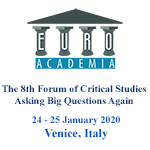Euroacademia Conferences
 Europe Inside-Out: Europe and Europeanness Exposed to Plural Observers (9th Edition) April 24 - 25, 2020
Europe Inside-Out: Europe and Europeanness Exposed to Plural Observers (9th Edition) April 24 - 25, 2020 Identities and Identifications: Politicized Uses of Collective Identities (9th Edition) June 12 - 13, 2020
Identities and Identifications: Politicized Uses of Collective Identities (9th Edition) June 12 - 13, 2020 8th Forum of Critical Studies: Asking Big Questions Again January 24 - 25, 2020
8th Forum of Critical Studies: Asking Big Questions Again January 24 - 25, 2020 Re-Inventing Eastern Europe (7th Edition) December 13 - 14, 2019
Re-Inventing Eastern Europe (7th Edition) December 13 - 14, 2019 The European Union and the Politicization of Europe (8th Edition) October 25 - 26, 2019
The European Union and the Politicization of Europe (8th Edition) October 25 - 26, 2019 Identities and Identifications: Politicized Uses of Collective Identities (8th Edition) June 28 - 29, 2019
Identities and Identifications: Politicized Uses of Collective Identities (8th Edition) June 28 - 29, 2019 The European Union and the Politicization of Europe (7th Edition) January 25 - 26, 2019
The European Union and the Politicization of Europe (7th Edition) January 25 - 26, 2019 7th Forum of Critical Studies: Asking Big Questions Again November 23 - 24, 2018
7th Forum of Critical Studies: Asking Big Questions Again November 23 - 24, 2018 Europe Inside-Out: Europe and Europeanness Exposed to Plural Observers (8th Edition) September 28 - 30, 2018
Europe Inside-Out: Europe and Europeanness Exposed to Plural Observers (8th Edition) September 28 - 30, 2018 Identities and Identifications: Politicized Uses of Collective Identities (7th Edition) June 14 - 15, 2018
Identities and Identifications: Politicized Uses of Collective Identities (7th Edition) June 14 - 15, 2018
Cultural Diplomacy “of Great Propagandistic Value”: The First Russian Art Exhibition in Berlin 1922
-
-

-
Presentation speakers
- Viktor Kempf, Albert-Ludwigs-Universität Freiburg, Germany
- Download presentation
Abstract:
The First Russian Art Exhibition in Berlin in 1922 was by then certainly the major event of official Soviet cultural diplomacy in Germany. It was a materialization of the Treaty of Rapallo, signed between Soviet Russia and Germany in April 1922, that marked the beginning of a German-Soviet special relationship within the cultural sphere. In my paper I intend to contextualize the exhibition within the development of Soviet cultural diplomacy in Germany and to give an insight into the institutional possibilities and restraints for Soviet artists that varied within the 1920s. The exhibition was organized by the Workers’ Relief Organisation and the People’s Commissariat for Education, including professional artists such as David Sterenberg and Nathan Altman. It is representative for a period when artists were involved in decision-making processes. One goal was to correct the exile emigrants’ accusations towards the Bolshevik state for destroying czarist cultural property. Including various artistic tendencies, it served to create ties to prerevolutionary art traditions. At the same time, it was a successful attempt to foster understanding for Soviet art trends within the German public and it also reflects the transition in Soviet foreign policy from enforcing revolutionary revolts towards entering bilateral alliances in order to consolidate the young state. Whereas obvious propaganda was avoided, the exhibition was regarded as being of great propagandistic value for the Bolshevik state. This circumstance shows the necessity to reflect on and to historicize our terminology in different contexts of space and time. Especially the concepts of propaganda, cultural diplomacy and soft power require a precise distinction and definition. The First Russian Art Exhibition served as a blueprint for several art exhibitions between Germany and the USSR during the Cold War period, when politicians built on the experience from this famous event.
-
Related Presentations

"The Revolution Will Be Feminist or It Will Be Nothing": Consciousness Raising and Sexual Liberation in the Sixties and Seventies
- Virginia Niri













